The chapter I chose for our group reading of Fried was number seven: Portraits by Thomas Struth, Rineke Dijkstra, Patrick Faigenbaum, Luc Delahaye, and Roland Fischer; Douglas Gordon and Philippe Parenno's film Zidane. The main device of this chapter is to study how notions of anti-theatricality have evolved through the portraiture section of what Fried sees as a new regime of photography. Fried dissects the work of each artist and discusses how the work evokes notions of anti theatricality. The most interesting dimension of this chapter is the consideration Fried takes of the 'viewer' or 'audience' of the photograph and how the projected gaze or 'absorption' of the model depends on their awareness or 'unawareness ('oubli-de-soil') of its existence.

Thomas Struth, 'The Hirose Family, Hirosima, 1987'.

Thomas Struth, 'The Smith Family, Fife, 1989'.
Fried begins by discussing the issue of absorption and theatricality. He uses the work of Struth to demonstrate this issue. Fried notes that in the 1700's, the general consensus was that painting was only acceptable as valid art if it depicted its subjects as wholly absorbed in activity, unaware and ignorant of any form of viewer or audience. He notes that the limitation of painting was an issue at this time, as it was thought that portraiture and theatricality went hand in hand, therefore one could not be depicted truly through this medium. To counter this, it became essential that the subject in no way suggest they are aware of being transformed into an object to be looked at. He uses the example of Van Loo's painting of Diderot to solidify this. Fried mentions that Diderot was unhappy with the depiction, as he was being engaged by the artist, rather than left to his own thoughts and therefore he appears 'aware' or theatrical. I find this quite the contradiction, as the painting reminds me of a candid snapshot, taken mid sentence, displaying the sitter 'off-guard' and therefore more natural, but clearly Diderot does not acknowledge this. This brings us to the contrast between painting and photography with regards to portraiture.

Louis Michel Van Loo, 'Portrait of Denis Diderot, 1767'.
One of the most striking features of Struth's family portraits is that of familial resemblance. Fried notes the ability of photography to represent phenomena such as this so effortlessly is one of its strong points. He sees this as one of the main ontological differences between painting and photography. He uses Wittgenstein's quote about the absurdity of attempting to display resemblance in panting, as it could simply be perceived as a style or habit of the artists. Where as in photography, it is instantly accepted that the models are different people despite the similarities of their physical features. Fried discusses the work of Struth in relation to this matter, thus beginning the main discussion of the chapter. Struth photographs families whom are close friends of his. He allows the family to choose their positions and poses in the photograph and he makes a point to step aside from the camera when shooting, using a shutter release cable, in order to remove himself from the situation, as if the family is sitting in front of a mirror rather than a photographer. What is most important however, according to Fried, is that Struth avoids the theatrical at all costs. Fried also discusses various critical opinions of Struth's work, noting that it has always been received unenthusiastically. Critic Charles Wylie claims that 'awareness is the hallmark of these figures' (199) and that each family is a 'psychologically intense entity'. He feels that the families awareness of themselves and their natural and played out connectivity combines to create the force of the picture. He recommends we read each family member as a separate entity and also as connected to a larger group. Fried believes this is too much to ask of the viewer and discusses the opinion of Norman Byron, who sees it as more productive to decipher the positional pattern chosen by the family and what this connotes. In his usual manner, Fried discusses the photographs extensively. However, what is most important is Fried's discussion of what makes these photographs anti theatrical. Fried call these works a 'tour de force of anti theatrical art' (204). He sees an achievement in Struth's work of the re staging of could potentially be theatrical. By taking such care to ensure the subjects gaze is concentrated on the lens and they are wholly aware of themselves (it should be noted that Fried's exposure are up to one second long and he shoot around 40-50 sheets per sitting), Struth's subjects, despite staring out of the picture, are absorbed in the activity of being photographed.

Rineke Dijkstra, 'Beach Portraits'.
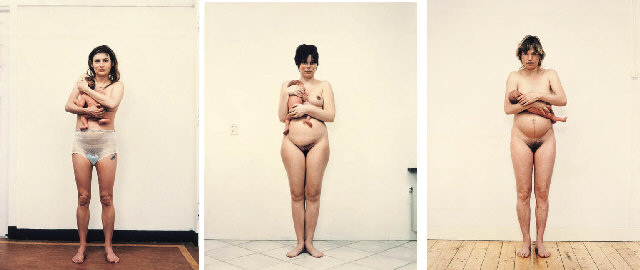
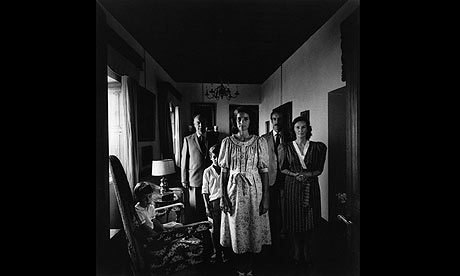
Patrick Faigenbaum, 'Del Drago Family, 1987'.

Patrick Faigenbaum, from 'Vies Pararlles'.

Hiroshi Suigimoto, (Wax Figures of Henty VIII's wives).

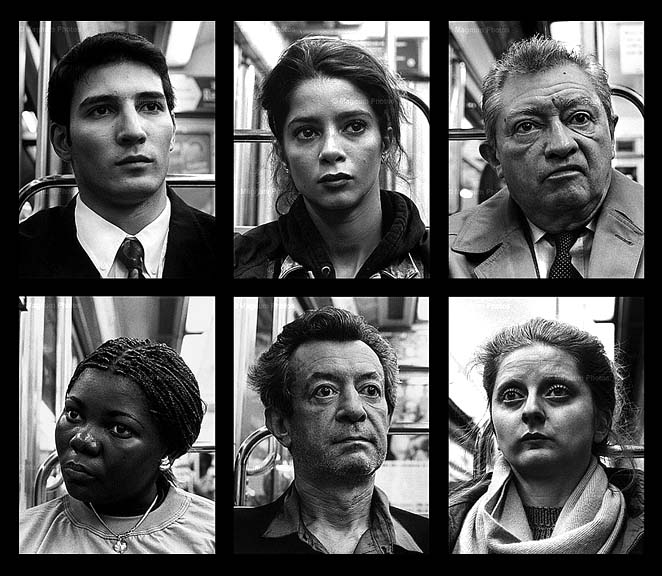

Rineke Dijkstra, 'Beach Portraits'.

Rineke Dijkstra, 'Mothers'.
Fried move on to discuss the work of Dijkstra. He notes that Dijkstra, unlike Struth, shoots strangers. However, her subjects are fully aware of th camera and are placed in a similar position to Struth's families. Fried points out that Dijkstra cites Diane Arbus as one of her main influences. Dijkstra notes that she is interested in what Abrus calls the "gap between intention and effect", in other words, Dijkstra is interested in what happens when neither her nor the subject is fully in control. For example, she is interested in what happens when she lets the model pose themselves and how they are unsure of what to do with their hands, etc. She is interested in the awkwardness of her subjects. This is particularly visible in her portraits of teenagers. However, where Arbus exploited this gap and displayed her subjects as freaks, Fried believes that Dijkstra's portraits de psychologicalize it. Arbus highlights a tragic side of society whilst Dijkstra draws attention to a natural and strangely beautiful part. Fried is interested in Dijkstra's photographs as they display something that painting could not, at least in Diderot's time. However, he notes the 'complimentary structure of awareness and unconsciousness' of the photographs are truly Diderotian in spirit and therefore wholly anti-theatrical. Fried takes this opportunity to enforce two further points. Firstly, he discusses Barthe's opinion that any photography that contains an outward gaze is founded on pose and theatricality. Fried feels the photographs he has discussed shatter this notion and leaves Barthe's opinion void. Secondly, he claims that the awareness of the camera displayed in both Struth and Dijkstra's work solidifies his opinion that, post-minimalism, it was necessary for art to acknowledge 'to-be-seeness' in the course of pursuing anti-theatrical aims. Therefore, separating anti-theatricality from 'to-be-seeneness' and establishing it 'on significantly new ground' (214). basically, what Fried is saying, that with the emergence of such work, anti-theatricality no longer meant avoiding gazing at the camera, hence why he is so interested.

Patrick Faigenbaum, 'Del Drago Family, 1987'.

Patrick Faigenbaum, from 'Vies Pararlles'.
Following this, Fried discusses the work of Patrick Faigenbaum. Firstly he discusses his work photographing aristocratic Italian families. The photographs are profoundly formal. Faigenbaum arranges his models, taking care to connote the family dynamic and relation to their surroundings. He notes that he is fully satisfied with the portrait when 'I am able to leave my model to himself...as if he were at home without any witness' (215). Obviously this connects to notions of anti-theatricality. Faigenbaum also actively tried to imitate a painterly style by touching up his photographs using a technique called chiaroscuro where the contrast between shadows and highlights is increased. He also prints his photographs on a matte finish paper. Fried notes all this allows the viewers gaze to 'sink into the surface rather than glide past it' (215). What Fried is more interested in, however, is Faigenbaum's series of busts of Roman emperors, 'Vies Pararlles'. Fried is interested in these images, as they represent a full invitation to, 'to-be-seenness' and display subjects engaging in full absorption, of course, as the subjects are representations of people lost in their own thoughts. Not only are they not really looking at us, they are not even real. Fried suggests that creating work that deals with anti-theatricality so intensely encouraged Faigenbaum to turn towards an absorptive esthetic in his later work. Fried also notes obvious comparisons to Hiroshi Suigimoto's work on wax figures of Henry VIII's wives at Madame Tussaud's wax work museum in London.

Hiroshi Suigimoto, (Wax Figures of Henty VIII's wives).
Moving on, Fried discusses the work of Luc Delahaye. The body of work he is discussing is 'L'Autre', a set of portraits similar to Evan's 'Many Are Called', shot secretly on the Paris Metro between 1995-1997. What struck me first about these photographs was the almost eerie resemblance they share with Faigenbaum's busts or Suigimoto's wax figures. This particular body of work interests Fried, but also me very much so, as I am extremely interested in studying the effects of urban living on the human psyche and Delahaye's work, similar to Evans, is a fascinating example of this. Fried notes that this work is 'claustrophobic in its intensity' (222) as the photographs are shot at a much closer range than Evans'. Why does this work interest Fried? It is a contradiction. The subjects are painfully aware they are coming under the enforced gaze of the occupier in the seat facing them and therefore put up what Georg Simmel calls a 'psychic armour', (1903 The Metropolis and Mental Life). The subjects put on a farcical show, which is rather comedic when one thinks about it really, pretending they are alone in order to avoid any emotional connection to those surrounding them (Simmel notes that if a city dweller engaged with every person encountered in such a situation in city life, the result would be a form of intellectual or emotional break down). However, Delahaye intrudes on this psychic armour with his camera and transforms this theatrical display into the anti-theatrical. In terms of the camera, none of the models are posing or acting, in direct contrast to the real life situation. I find this notion of how the introduction of the camera into a situation can transform such a process. Delahaye's portraits also connect back to Fried's previous discussion of the book Temple of Dawn, as the photographer notes 'more than anything, I wish to disappear' (222).


Luc Delahaye, 'L'Autre'.
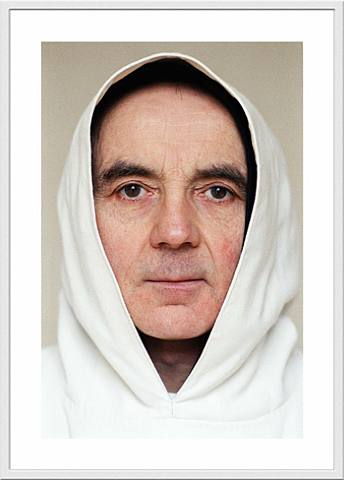
Roland Fischer, 'Nuns and Monks'.


Roland Fischer, 'Nuns and Monks'.
Fried continues on to discuss the work of Roland Fischer. Fischer is interested in seizing things in their 'leur etre-la', their 'being there'. His work comprises of large head shots of monks and nuns. Fried notes the work 'perfectly exemplifies' anti-theatricality and his new photographic regime, as the subjects photographed live a life that is supposedly free of anything but absorption in their faith. I would argue that, yes these photographs do exemplify Fried's opinions perfectly, but there is also a questionable element of theatricality in this work. Are subjects are playing out their 'holiness' for the camera? Or are they truly absorbed in their beliefs? For me, this is questionable and the photographs raise many other questions in my mind, but for Fried, the main significance is the element of anti-theatricality and absorption.

Finally, Fried discusses the film 'Zidane: A 21st Century Portrait' by Douglas Gordon and Philippe Parreno. This film focusses on Real Madrid footballer Zinedine Zidane. The movie was made with seventeen cameras focusing on the player during a match between Villareal and Real Madrid. The film glorifies Zidane as one of the centuries best football players, following his expulsion from the 2006 World Cup after head-butting an opposing team member. Fried describes the tantalizing visual and audio effect of the movie which has obviously enthralled him. He notes that the noise of the crowd in the background mixed with Zidane's statements appearing in the subtitles, hard breathing noises, music by the Scottish (amazing) band Mogwai, silence and close up motion shots, action shots of foot work, along with wide angle shots of the exciting football game makes for an intriguing visual experience. I can see why Fried is attracted to such a film for two reasons. Firstly, the directors cite Goya, Velazques and Andy Warhol as their inspirations, therefore connecting it to a tradition of modernist painting. Secondly, the point of the film is to display how truly absorbed Zidane is in his performance, but showing at the same time his hyper awareness of the crowd and the cameras. Fried believes this so much so that he claims one can only fully understanding the movie 'requires viewing it against the background of the issues traced in the present chapter and more broadly, this book' (228).
There is a reason Fried chose these specific pieces to discuss in this chapter. Each work is an example of what Fried considers to be a 'new photographic regime'. He sees these works as coming to grips with the problems of portraiture that came to light in the 1700's. Anti-theatricality has evolved from a complete (supposed) unawareness of being beheld, as in the work of Greze and Chandin to a hyper awareness and being absorbed in the very act of being observed. Freid sees this type of photography as a 'realm of to-be-seenness.. with a vengeance' (230). Fried sees this work as the anti-thesis of anti-theatricality, in its evolved state. For example, Fried notes that the very fact that Gordon and Parenno made a film dealing with Zidane's awareness and simultaneous absorption is an affirmation of his theories, that issues of theatricality and anti-theatricality are more important than ever. Fried notes that this new hyper awareness does not in anyway undermine the art. He is also fascinated by the various forms of absorption, involved, uninvolved, distracted, forgetful, etc. This chapter makes very clear why Fried believes photography matters as never before: the work being made solidifies his theories of anti-theatricality and absorption.
Conclusion:
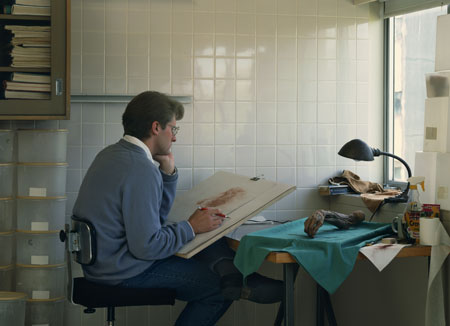
Jeff Wall, 'Adrian Walker'.
Fried begins his conclusion by making it clear that despite his claim that photography matters as art now as never before, he does not believe that art, pre 1970 is not as valid or important as art now. Fried, however, sees contemporary photography post 1970 as exemplifying his theories of anti-theatricality and absorption and there for claims photography matters as never before. He discusses questions of whether photography is art or not, by quoting Benn Michaels who notes photography, rather than painting raises fundamental questions about representation. He also discusses James Elkin's discussion of the photograph as an indexical object, therefore, a non art object. Michaels along with Fried, however, firmly believes that it is this very factor that makes photography such a powerful tool of contemporary art (336). Fried sees the issues of photography as overriding the issues of painting. For example, he discusses the problems of portraiture (Evans questionable portraits with the FSA, Arbus' demeaning photographs of 'freaks') and how the real issue at hand is a notion of theatricality and anti-theatricality and how it is employed. He sees a photographer such as Arbus as abusive of the technique, (abusing the gap between intention and effect) but a photographer who works similarly, such as Dijkstra, as employing anti-theatricality perfectly. Fried repeats many of his comments made about the work of Dijkstra, Struth, Bustamante and Wall and I will therefore not go back into detail as I would be wasting your time. Fried does however pay particular attention to Wall, comparing his photographic style to Manet, noting he moved towards an alternative revolutions of pictorial modernity (341). He notes that his photograph 'Adrian Walker' represents a shift in Wall's working method, his realization that such a revolution would be impossible and thus, a return to previous methods of absorption.
However, this break, as Fried sees it also represents a shift in anti-theatricality. The pressure to represent subjects absorbed in activity was no longer tangible. Now, this type of representation is a choice, a technique, (most obviously employed by Wall), not a necessity. According to Fried, artists no longer try to come up with alternatives to theatricality, but simply embrace anti-theatricality. A good example of this is Struth's portraits of families. Fried also notes that all this progress is only important and relevant against a backdrop of Diderotian history. Fried goes on to mention a number of works in detail that owe their success to anit-theatricality, such as Struth's Pergamon Museum series, Gursky's motifs, Delahaye's metro portraits. Fried also discusses works that connect to notions of the experiential, indeterminacy and minimalism (Suigimoto's 'Seascapes', Struth's 'Paradise', Bustamante's 'Tableaux'). Fried begins to confuse me at this stage as my knowledge of such subjects is limited. I think he brings these themes into the conversation in order to display the connection his previous writings still has to current art. He goes on to discuss Barthes text 'Camera Lucida' as an anti-theatrical text and therefore representing 'a new imperative to come to grips with the issue of theatricality' (346). He mentions writers such as Wittgenstein, Lacan, Deleuze, Pippin and Hegel and ponders which authors offers the most valid theory on art. Again, I feel unequipped to comment as my reading experience with these authors is very limited. At this stage, I wonder is Fried digressing, or am I just out of my depth. The only point I could really understand out of this paragraph was his quote about photography being illuminated by ontological thought whilst also contributing to such thought.
However, this break, as Fried sees it also represents a shift in anti-theatricality. The pressure to represent subjects absorbed in activity was no longer tangible. Now, this type of representation is a choice, a technique, (most obviously employed by Wall), not a necessity. According to Fried, artists no longer try to come up with alternatives to theatricality, but simply embrace anti-theatricality. A good example of this is Struth's portraits of families. Fried also notes that all this progress is only important and relevant against a backdrop of Diderotian history. Fried goes on to mention a number of works in detail that owe their success to anit-theatricality, such as Struth's Pergamon Museum series, Gursky's motifs, Delahaye's metro portraits. Fried also discusses works that connect to notions of the experiential, indeterminacy and minimalism (Suigimoto's 'Seascapes', Struth's 'Paradise', Bustamante's 'Tableaux'). Fried begins to confuse me at this stage as my knowledge of such subjects is limited. I think he brings these themes into the conversation in order to display the connection his previous writings still has to current art. He goes on to discuss Barthes text 'Camera Lucida' as an anti-theatrical text and therefore representing 'a new imperative to come to grips with the issue of theatricality' (346). He mentions writers such as Wittgenstein, Lacan, Deleuze, Pippin and Hegel and ponders which authors offers the most valid theory on art. Again, I feel unequipped to comment as my reading experience with these authors is very limited. At this stage, I wonder is Fried digressing, or am I just out of my depth. The only point I could really understand out of this paragraph was his quote about photography being illuminated by ontological thought whilst also contributing to such thought.

Jeff Wall, 'After "Spring Snow", by Yukio Mishima, chapter 34, 2000-2005'.
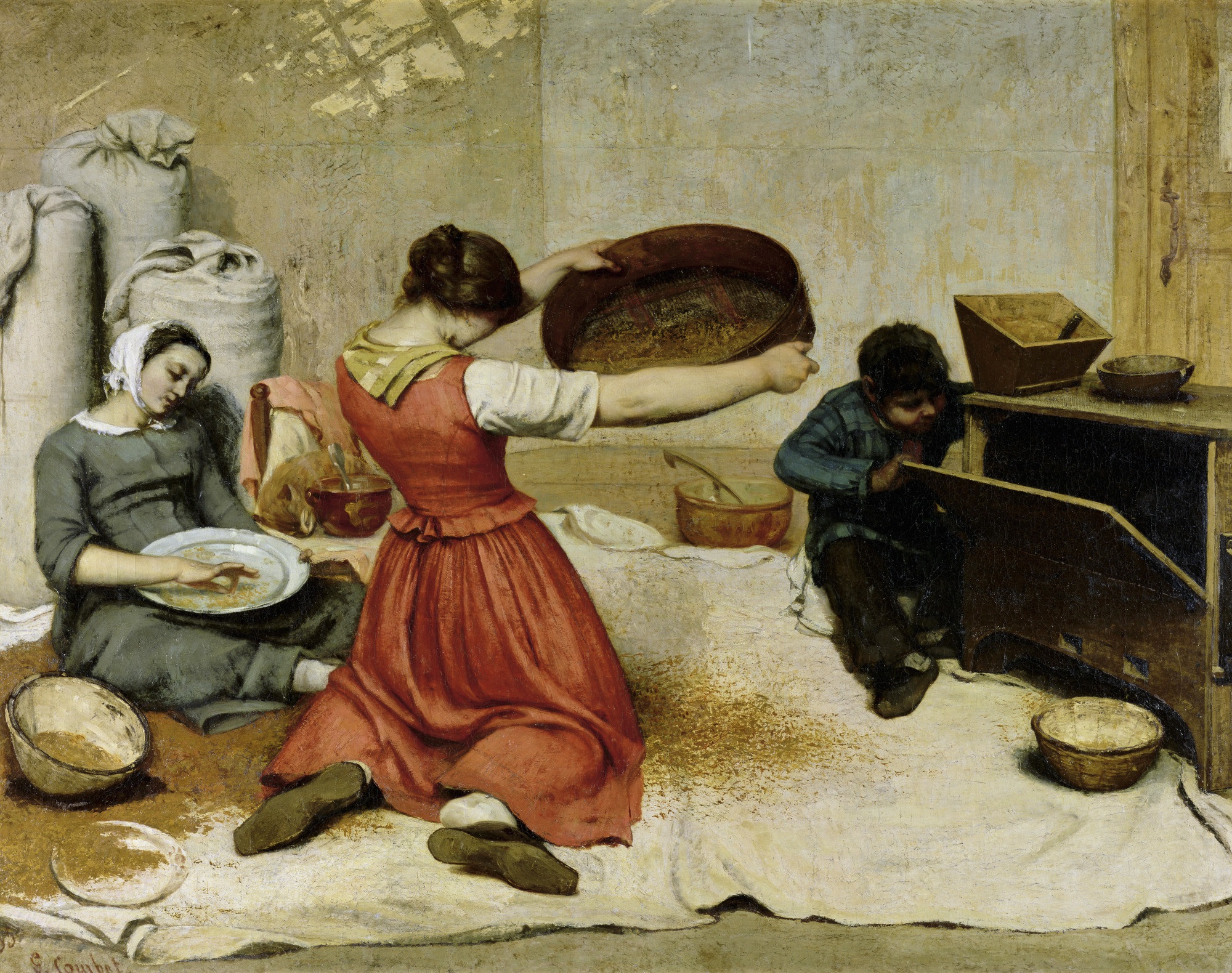
Gustave Courbet, 'Wheat Sifters'.
Fried begins his final section with two quotes, one from the book 'The Sea of Fertility' and the other from Wittgenstein. Both quotes deal with notions of the world as eternal present and this is where things get rather philosophical indeed. Fried discusses the book, 'The Sea of Fertility' and its relation to Wall's 'After "Spring Snow", by Yukio Mishima, chapter 34, 2000-2005'. This photograph represents a scene from the book where Satako empties sand from her shoe in order to keep secret her forbidden meeting with her lover, Kiyoaki, as we all have read. Fried chooses to close with this photograph as he feels it perfectly exemplifies 'robustness of absorption as a pictorial trope' (350). He sees deep similarities of the photograph to Courbet's 'Wheat Sifters' and therefore sees Wall's picture as a perfect visualization of all he believes in. The photograph represents anti-theatricality and absorption and it has deep roots in modernist painting and writing. In relation to the book, Fried notes the character Honda's affinity for Buddhist beliefs in 'alaya consciousness', a consciousness that discards the past and focuses only on the present, seeing every moment except the very moment we are in as non-existent. Fried takes this opportunity to mention a quote by Jonathon Edwards discussing God's desire to maintain the world in the present. He notes that a critic, Jennifer Ashton sees similarity in what has been said to Fried's Art and Objecthood's critique of Minimalism. He notes that Wall's photograph and such theories of art as absorption and presentness over minimalism and also theories of 'alaya consciousness' are all interconnected and are 'hauntingly anti-theatrical' (352).
So what's Fried's point? I am very unsure and this frustrates me greatly. Chapter Seven made a lot of sense to me and I could see real connections to his arguments and contemporary art. I could understand how, yes, some works owe their success to anti-theatricality and this is largely left ignored. His examples were clear and illustrated his points rather successfully. However, when he began to philosophize and connect his writing to some sub rooted web of spiritual theory, that's when I lost interest in even attempting to decipher what he was trying to say. Fried has some really interesting things to say. His points are valid and very pertinent and essential to understanding a large portion of art. If he avoided going long winded and unnecessary paragraphs such as those we had to struggle through in his conclusion, I think his writing would appeal to a much wider audience.
So what's Fried's point? I am very unsure and this frustrates me greatly. Chapter Seven made a lot of sense to me and I could see real connections to his arguments and contemporary art. I could understand how, yes, some works owe their success to anti-theatricality and this is largely left ignored. His examples were clear and illustrated his points rather successfully. However, when he began to philosophize and connect his writing to some sub rooted web of spiritual theory, that's when I lost interest in even attempting to decipher what he was trying to say. Fried has some really interesting things to say. His points are valid and very pertinent and essential to understanding a large portion of art. If he avoided going long winded and unnecessary paragraphs such as those we had to struggle through in his conclusion, I think his writing would appeal to a much wider audience.

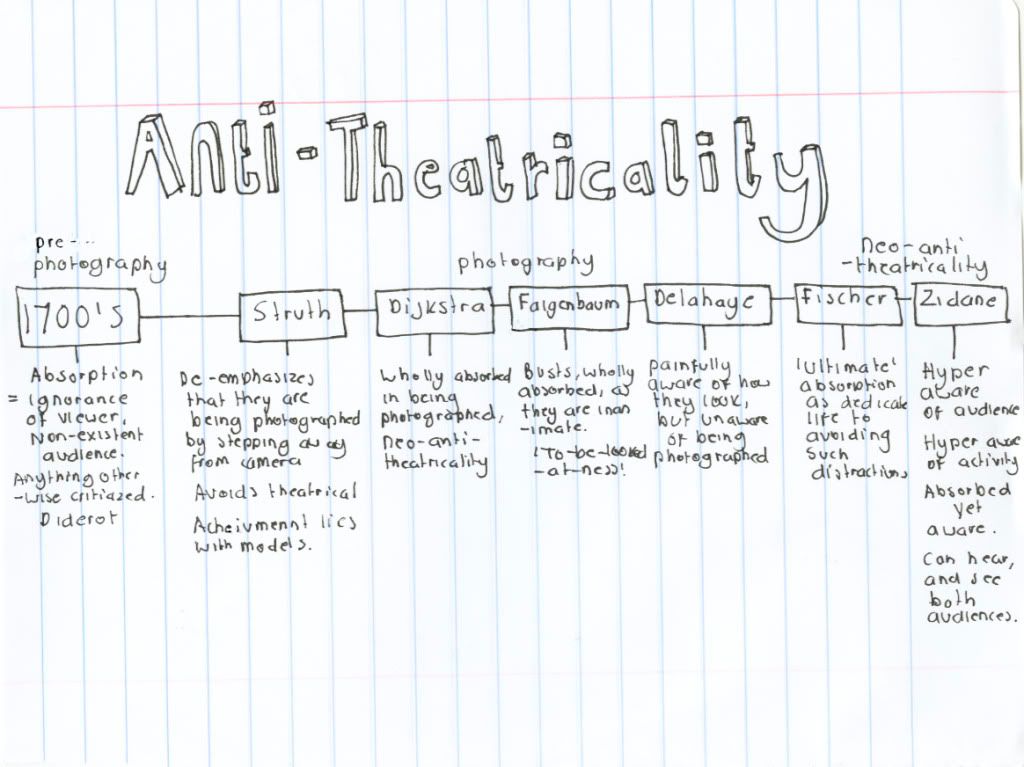
instagram takipçi satın al
ReplyDeleteucuz takipçi
takipçi satın al
https://takipcikenti.com
https://ucsatinal.org
instagram takipçi satın al
https://perdemodelleri.org
https://yazanadam.com
instagram takipçi satın al
balon perdeler
petek üstü perde
mutfak tül modelleri
kısa perde modelleri
fon perde modelleri
tül perde modelleri
https://atakanmedya.com
https://fatihmedya.com
https://smmpaketleri.com
https://takipcialdim.com
https://yazanadam.com
yasaklı sitelere giriş
aşk kitapları
yabancı şarkılar
sigorta sorgula
https://cozumlec.com
word indir ücretsiz
tiktok jeton hilesi
rastgele görüntülü sohbet
fitness moves
gym workouts
https://marsbahiscasino.org
http://4mcafee.com
http://paydayloansonlineare.com
Casinos Near Casinos Near Casinos in Philadelphia, PA
ReplyDelete1 Mohegan 경상북도 출장안마 Sun Blvd. Uncasville, CT 06382. 의정부 출장샵 Directions · (888) 226-1000. Call Now · 포항 출장샵 More Info. Hours, Accepts Credit Cards, 김해 출장샵 Wi-Fi, 충주 출장안마 PokéStop.
Smm panel
ReplyDeleteSMM PANEL
İş ilanları blog
İnstagram Takipçi Satın Al
hirdavatciburada.com
beyazesyateknikservisi.com.tr
servis
tiktok jeton hilesi
شركة فحص فلل بالدمام
ReplyDeleteفحص فلل
kadıköy
ReplyDeleteserdivan
çatalca
tunceli
fethiye
33LYO
diyarbakır
ReplyDeletekastamonu
hakkari
kütahya
muş
NB6MEV